2011 GMC SIERRA 1500 weight
[x] Cancel search: weightPage 328 of 594
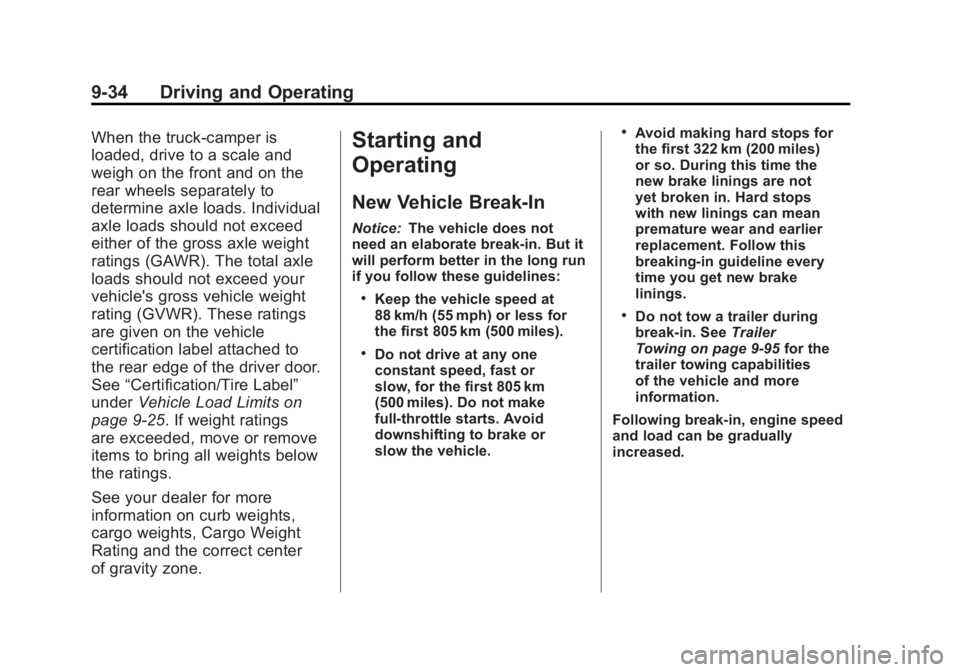
Black plate (34,1)GMC Sierra Owner Manual - 2011
9-34 Driving and Operating
When the truck‐camper is
loaded, drive to a scale and
weigh on the front and on the
rear wheels separately to
determine axle loads. Individual
axle loads should not exceed
either of the gross axle weight
ratings (GAWR). The total axle
loads should not exceed your
vehicle's gross vehicle weight
rating (GVWR). These ratings
are given on the vehicle
certification label attached to
the rear edge of the driver door.
See“Certification/Tire Label”
under Vehicle Load Limits on
page 9‑25. If weight ratings
are exceeded, move or remove
items to bring all weights below
the ratings.
See your dealer for more
information on curb weights,
cargo weights, Cargo Weight
Rating and the correct center
of gravity zone.Starting and
Operating
New Vehicle Break-In
Notice: The vehicle does not
need an elaborate break-in. But it
will perform better in the long run
if you follow these guidelines:
.Keep the vehicle speed at
88 km/h (55 mph) or less for
the first 805 km (500 miles).
.Do not drive at any one
constant speed, fast or
slow, for the first 805 km
(500 miles). Do not make
full-throttle starts. Avoid
downshifting to brake or
slow the vehicle.
.Avoid making hard stops for
the first 322 km (200 miles)
or so. During this time the
new brake linings are not
yet broken in. Hard stops
with new linings can mean
premature wear and earlier
replacement. Follow this
breaking-in guideline every
time you get new brake
linings.
.Do not tow a trailer during
break-in. See Trailer
Towing on page 9‑95 for the
trailer towing capabilities
of the vehicle and more
information.
Following break‐in, engine speed
and load can be gradually
increased.
Page 336 of 594
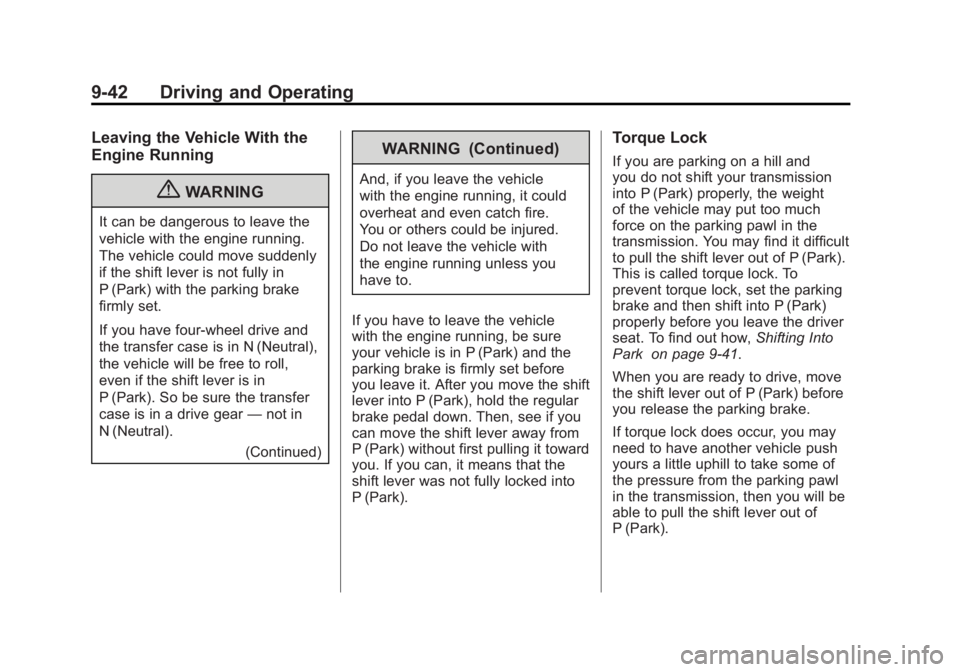
Black plate (42,1)GMC Sierra Owner Manual - 2011
9-42 Driving and Operating
Leaving the Vehicle With the
Engine Running
{WARNING
It can be dangerous to leave the
vehicle with the engine running.
The vehicle could move suddenly
if the shift lever is not fully in
P (Park) with the parking brake
firmly set.
If you have four-wheel drive and
the transfer case is in N (Neutral),
the vehicle will be free to roll,
even if the shift lever is in
P (Park). So be sure the transfer
case is in a drive gear—not in
N (Neutral).
(Continued)
WARNING (Continued)
And, if you leave the vehicle
with the engine running, it could
overheat and even catch fire.
You or others could be injured.
Do not leave the vehicle with
the engine running unless you
have to.
If you have to leave the vehicle
with the engine running, be sure
your vehicle is in P (Park) and the
parking brake is firmly set before
you leave it. After you move the shift
lever into P (Park), hold the regular
brake pedal down. Then, see if you
can move the shift lever away from
P (Park) without first pulling it toward
you. If you can, it means that the
shift lever was not fully locked into
P (Park).
Torque Lock
If you are parking on a hill and
you do not shift your transmission
into P (Park) properly, the weight
of the vehicle may put too much
force on the parking pawl in the
transmission. You may find it difficult
to pull the shift lever out of P (Park).
This is called torque lock. To
prevent torque lock, set the parking
brake and then shift into P (Park)
properly before you leave the driver
seat. To find out how, Shifting Into
Park on page 9‑41.
When you are ready to drive, move
the shift lever out of P (Park) before
you release the parking brake.
If torque lock does occur, you may
need to have another vehicle push
yours a little uphill to take some of
the pressure from the parking pawl
in the transmission, then you will be
able to pull the shift lever out of
P (Park).
Page 384 of 594
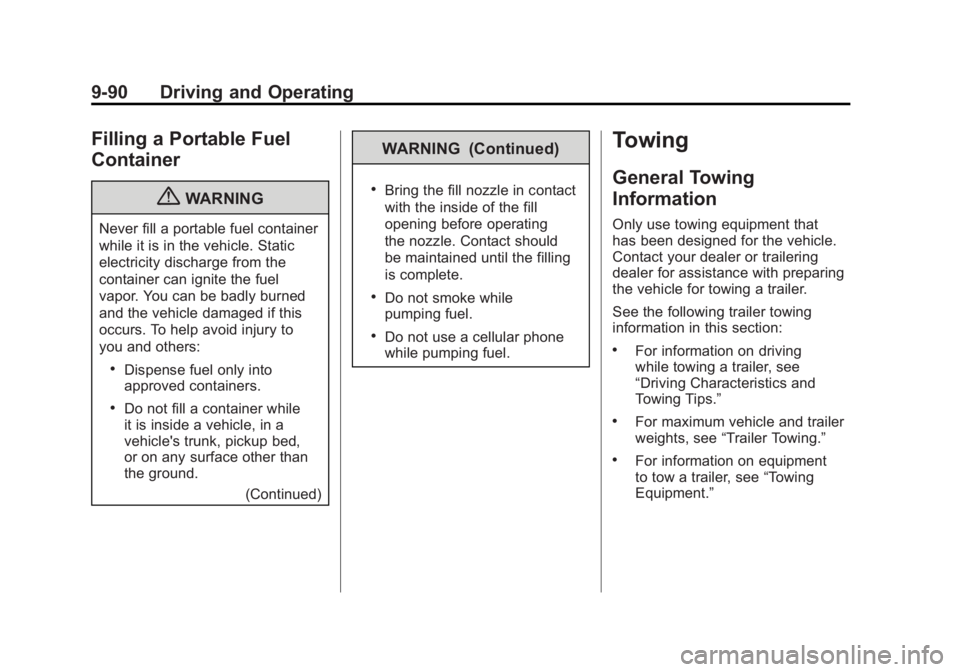
Black plate (90,1)GMC Sierra Owner Manual - 2011
9-90 Driving and Operating
Filling a Portable Fuel
Container
{WARNING
Never fill a portable fuel container
while it is in the vehicle. Static
electricity discharge from the
container can ignite the fuel
vapor. You can be badly burned
and the vehicle damaged if this
occurs. To help avoid injury to
you and others:
.Dispense fuel only into
approved containers.
.Do not fill a container while
it is inside a vehicle, in a
vehicle's trunk, pickup bed,
or on any surface other than
the ground.(Continued)
WARNING (Continued)
.Bring the fill nozzle in contact
with the inside of the fill
opening before operating
the nozzle. Contact should
be maintained until the filling
is complete.
.Do not smoke while
pumping fuel.
.Do not use a cellular phone
while pumping fuel.
Towing
General Towing
Information
Only use towing equipment that
has been designed for the vehicle.
Contact your dealer or trailering
dealer for assistance with preparing
the vehicle for towing a trailer.
See the following trailer towing
information in this section:
.For information on driving
while towing a trailer, see
“Driving Characteristics and
Towing Tips.”
.For maximum vehicle and trailer
weights, see“Trailer Towing.”
.For information on equipment
to tow a trailer, see “Towing
Equipment.”
Page 385 of 594
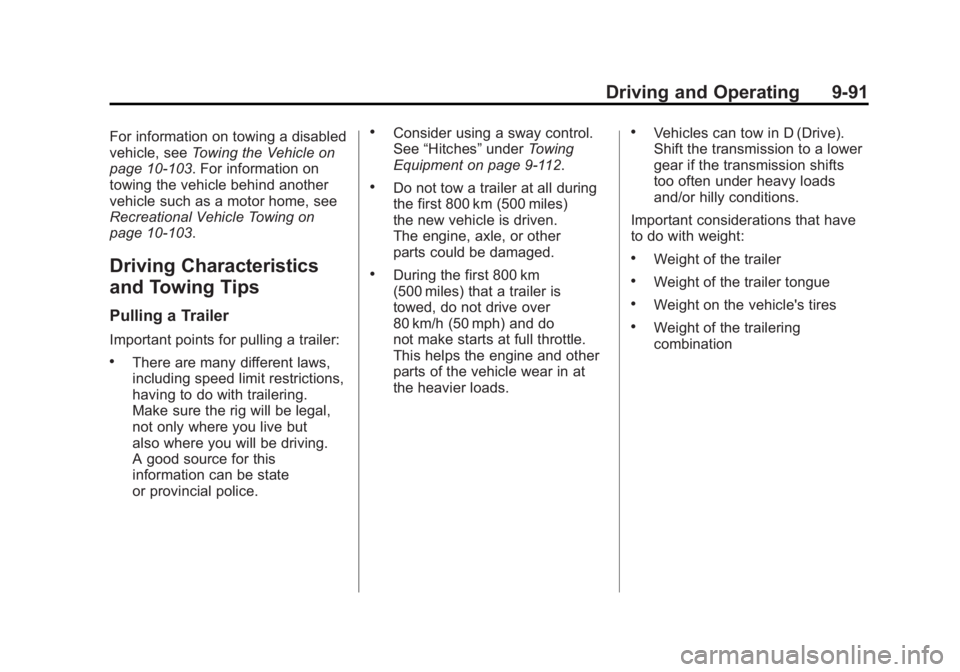
Black plate (91,1)GMC Sierra Owner Manual - 2011
Driving and Operating 9-91
For information on towing a disabled
vehicle, seeTowing the Vehicle on
page 10‑103. For information on
towing the vehicle behind another
vehicle such as a motor home, see
Recreational Vehicle Towing on
page 10‑103.
Driving Characteristics
and Towing Tips
Pulling a Trailer
Important points for pulling a trailer:
.There are many different laws,
including speed limit restrictions,
having to do with trailering.
Make sure the rig will be legal,
not only where you live but
also where you will be driving.
A good source for this
information can be state
or provincial police.
.Consider using a sway control.
See “Hitches” underTowing
Equipment on page 9‑112.
.Do not tow a trailer at all during
the first 800 km (500 miles)
the new vehicle is driven.
The engine, axle, or other
parts could be damaged.
.During the first 800 km
(500 miles) that a trailer is
towed, do not drive over
80 km/h (50 mph) and do
not make starts at full throttle.
This helps the engine and other
parts of the vehicle wear in at
the heavier loads.
.Vehicles can tow in D (Drive).
Shift the transmission to a lower
gear if the transmission shifts
too often under heavy loads
and/or hilly conditions.
Important considerations that have
to do with weight:
.Weight of the trailer
.Weight of the trailer tongue
.Weight on the vehicle's tires
.Weight of the trailering
combination
Page 389 of 594

Black plate (95,1)GMC Sierra Owner Manual - 2011
Driving and Operating 9-95
Leaving After Parking on a Hill
1. Apply and hold the brake pedal.
2. Start the engine.
3. Shift into a gear.
4. Release the parking brake.
5. Let up on the brake pedal.
6. Drive slowly until the trailer isclear of the chocks.
7. Stop and have someone pick up
and store the chocks.
Maintenance when Trailer
Towing
The vehicle needs service more
often when pulling a trailer. See this
manual's Maintenance Schedule
or Index for more information.
Things that are especially important
in trailer operation are automatic
transmission fluid, engine oil, axle
lubricant, belts, cooling system,
and brake system. It is a good
idea to inspect these before
and during the trip.
Check periodically to see that all
hitch nuts and bolts are tight.
Trailer Towing
If the vehicle has a diesel engine,
see the Duramax diesel supplement
for more information.
If the vehicle is a hybrid, see
the hybrid supplement for more
information.
Do not tow a trailer during break‐in.
See New Vehicle Break-In on
page 9‑34 for more information.
{WARNING
The driver can lose control when
pulling a trailer if the correct
equipment is not used or the
vehicle is not driven properly.
For example, if the trailer is too
heavy, the brakes may not work
well or even at all. The driver and
passengers could be seriously
injured. The vehicle may also be
damaged; the resulting repairs
would not be covered by the
(Continued)
WARNING (Continued)
vehicle warranty. Pull a trailer
only if all the steps in this section
have been followed. Ask your
dealer for advice and information
about towing a trailer with the
vehicle.
Notice: Pulling a trailer
improperly can damage the
vehicle and result in costly
repairs not covered by the
vehicle warranty. To pull a trailer
correctly, follow the advice in
this section and see your dealer
for important information about
towing a trailer with the vehicle.
To identify the trailering capacity of
the vehicle, read the information in
“Weight of the Trailer” later in this
section.
Page 390 of 594
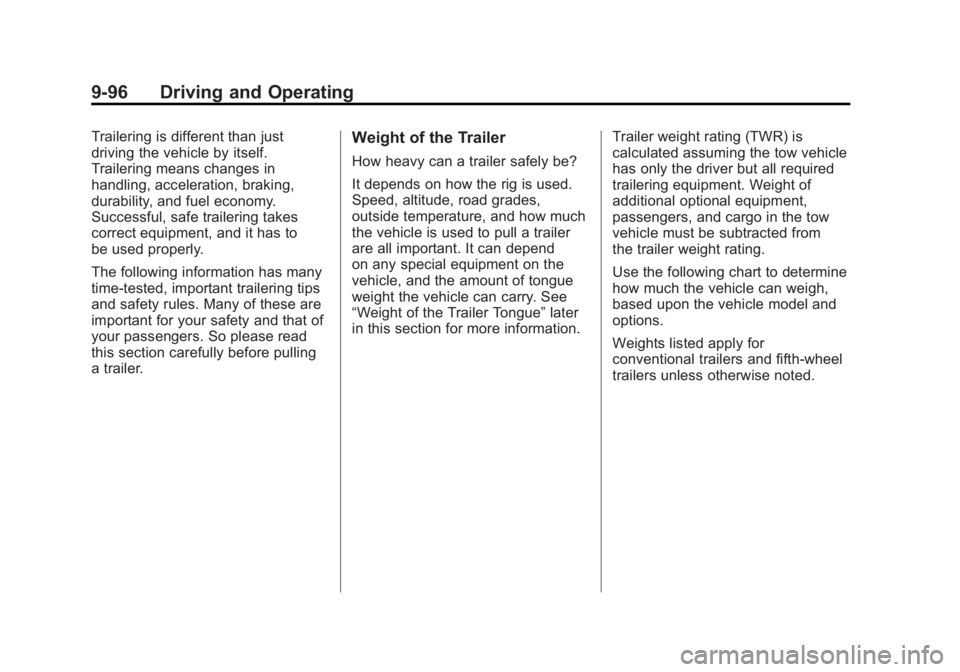
Black plate (96,1)GMC Sierra Owner Manual - 2011
9-96 Driving and Operating
Trailering is different than just
driving the vehicle by itself.
Trailering means changes in
handling, acceleration, braking,
durability, and fuel economy.
Successful, safe trailering takes
correct equipment, and it has to
be used properly.
The following information has many
time-tested, important trailering tips
and safety rules. Many of these are
important for your safety and that of
your passengers. So please read
this section carefully before pulling
a trailer.Weight of the Trailer
How heavy can a trailer safely be?
It depends on how the rig is used.
Speed, altitude, road grades,
outside temperature, and how much
the vehicle is used to pull a trailer
are all important. It can depend
on any special equipment on the
vehicle, and the amount of tongue
weight the vehicle can carry. See
“Weight of the Trailer Tongue”later
in this section for more information. Trailer weight rating (TWR) is
calculated assuming the tow vehicle
has only the driver but all required
trailering equipment. Weight of
additional optional equipment,
passengers, and cargo in the tow
vehicle must be subtracted from
the trailer weight rating.
Use the following chart to determine
how much the vehicle can weigh,
based upon the vehicle model and
options.
Weights listed apply for
conventional trailers and fifth-wheel
trailers unless otherwise noted.
Page 391 of 594
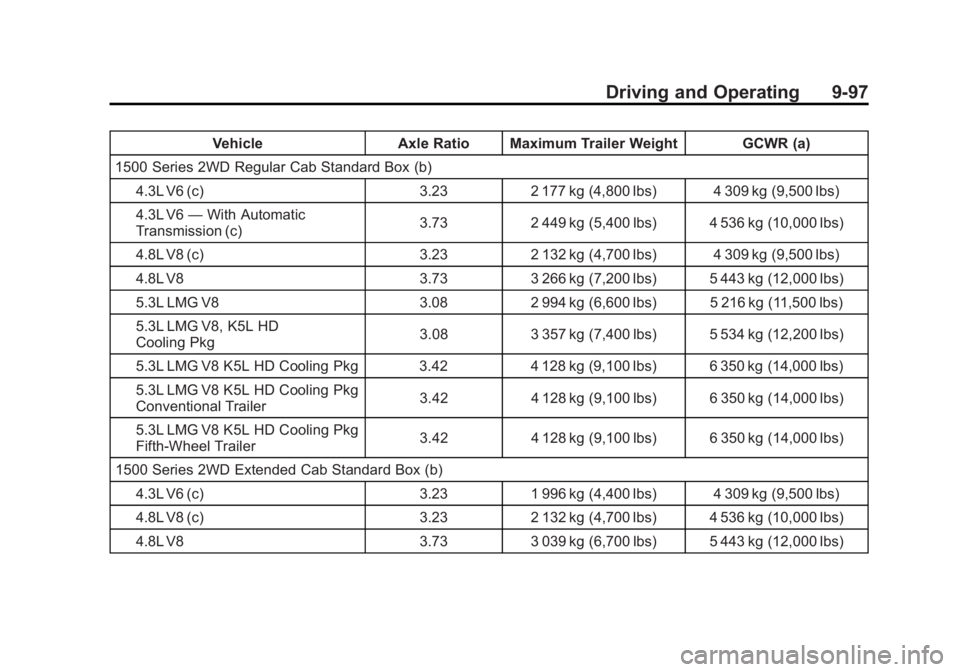
Black plate (97,1)GMC Sierra Owner Manual - 2011
Driving and Operating 9-97
VehicleAxle Ratio Maximum Trailer Weight GCWR (a)
1500 Series 2WD Regular Cab Standard Box (b) 4.3L V6 (c) 3.232 177 kg (4,800 lbs) 4 309 kg (9,500 lbs)
4.3L V6 —With Automatic
Transmission (c) 3.73
2 449 kg (5,400 lbs) 4 536 kg (10,000 lbs)
4.8L V8 (c) 3.232 132 kg (4,700 lbs) 4 309 kg (9,500 lbs)
4.8L V8 3.733 266 kg (7,200 lbs) 5 443 kg (12,000 lbs)
5.3L LMG V8 3.082 994 kg (6,600 lbs) 5 216 kg (11,500 lbs)
5.3L LMG V8, K5L HD
Cooling Pkg 3.08
3 357 kg (7,400 lbs) 5 534 kg (12,200 lbs)
5.3L LMG V8 K5L HD Cooling Pkg 3.42 4 128 kg (9,100 lbs) 6 350 kg (14,000 lbs)
5.3L LMG V8 K5L HD Cooling Pkg
Conventional Trailer 3.42
4 128 kg (9,100 lbs) 6 350 kg (14,000 lbs)
5.3L LMG V8 K5L HD Cooling Pkg
Fifth-Wheel Trailer 3.42
4 128 kg (9,100 lbs) 6 350 kg (14,000 lbs)
1500 Series 2WD Extended Cab Standard Box (b) 4.3L V6 (c) 3.231 996 kg (4,400 lbs) 4 309 kg (9,500 lbs)
4.8L V8 (c) 3.232 132 kg (4,700 lbs) 4 536 kg (10,000 lbs)
4.8L V8 3.733 039 kg (6,700 lbs) 5 443 kg (12,000 lbs)
Page 392 of 594
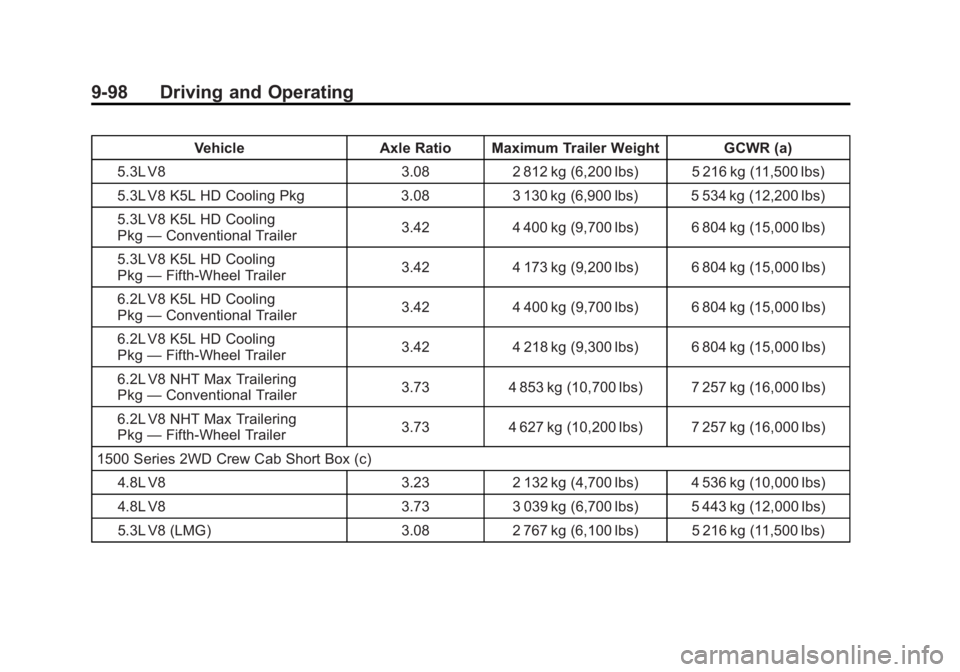
Black plate (98,1)GMC Sierra Owner Manual - 2011
9-98 Driving and Operating
VehicleAxle Ratio Maximum Trailer Weight GCWR (a)
5.3L V8 3.082 812 kg (6,200 lbs) 5 216 kg (11,500 lbs)
5.3L V8 K5L HD Cooling Pkg 3.083 130 kg (6,900 lbs) 5 534 kg (12,200 lbs)
5.3L V8 K5L HD Cooling
Pkg —Conventional Trailer 3.42
4 400 kg (9,700 lbs) 6 804 kg (15,000 lbs)
5.3L V8 K5L HD Cooling
Pkg —Fifth-Wheel Trailer 3.42
4 173 kg (9,200 lbs) 6 804 kg (15,000 lbs)
6.2L V8 K5L HD Cooling
Pkg —Conventional Trailer 3.42
4 400 kg (9,700 lbs) 6 804 kg (15,000 lbs)
6.2L V8 K5L HD Cooling
Pkg —Fifth-Wheel Trailer 3.42
4 218 kg (9,300 lbs) 6 804 kg (15,000 lbs)
6.2L V8 NHT Max Trailering
Pkg —Conventional Trailer 3.73
4 853 kg (10,700 lbs) 7 257 kg (16,000 lbs)
6.2L V8 NHT Max Trailering
Pkg —Fifth-Wheel Trailer 3.73
4 627 kg (10,200 lbs) 7 257 kg (16,000 lbs)
1500 Series 2WD Crew Cab Short Box (c) 4.8L V8 3.232 132 kg (4,700 lbs) 4 536 kg (10,000 lbs)
4.8L V8 3.733 039 kg (6,700 lbs) 5 443 kg (12,000 lbs)
5.3L V8 (LMG) 3.082 767 kg (6,100 lbs) 5 216 kg (11,500 lbs)